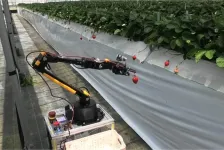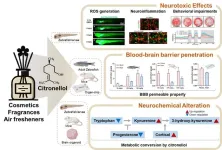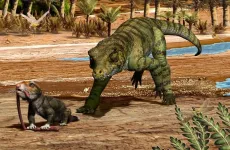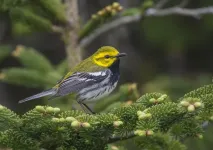Farm robot autonomously navigates, harvests among raised beds
Autonomous driving algorithm for robot using lidar shows promise with high-bed cultivation methods
2025-04-16
(Press-News.org)
Strawberry fields forever will exist for the in-demand fruit, but the laborers who do the backbreaking work of harvesting them might continue to dwindle. While raised, high-bed cultivation somewhat eases the manual labor, the need for robots to help harvest strawberries, tomatoes, and other such produce is apparent.
As a first step, Osaka Metropolitan University Assistant Professor Takuya Fujinaga has developed an algorithm for robots to autonomously drive in two modes: moving to a pre-designated destination and moving alongside raised cultivation beds. The Graduate School of Engineering researcher experimented with an agricultural robot that utilizes lidar point cloud data to map the environment.
Lidar, available on some high-end, pro-level smartphones and used by autonomous vehicles, uses light in laser pulses as a remote sensing method. The farming robot can thus move accurately while maintaining a constant distance from the cultivation bed, with its effectiveness verified in virtual and actual environments.
“If robots can move around the farm more precisely, the range of tasks that they can perform automatically will expand, not only for harvesting, but also for monitoring for disease and pruning,” Professor Fujinaga explained. “My research shows a possibility, and once this type of agricultural robot becomes more practical to use, it will make a significant contribution to improving work efficiency and reducing labor, especially for high-bed cultivation.”
The findings were published in Computers and Electronics in Agriculture.
###
About OMU
Established in Osaka as one of the largest public universities in Japan, Osaka Metropolitan University is committed to shaping the future of society through “Convergence of Knowledge” and the promotion of world-class research. For more research news, visit https://www.omu.ac.jp/en/ and follow us on social media: X, Facebook, Instagram, LinkedIn.
END
[Attachments] See images for this press release:

ELSE PRESS RELEASES FROM THIS DATE:
2025-04-16
By Dr Kelly Dunning
The Endangered Species Act (ESA), now 50 years old, was once a rare beacon of bipartisan unity, signed into law by President Richard Nixon with near-unanimous political support. Its purpose was clear: protect imperiled species and enable their recovery using the best available science to do so. Yet, as our case study on the grizzly bear in the Greater Yellowstone Ecosystem reveals, wildlife management under the ESA has changed, becoming a political battleground where science is increasingly drowned out by partisan ideology, bureaucratic delays, power struggles, and competing political interests. ...
2025-04-16
Citronellol, a rose-scented compound commonly found in cosmetics and household products, has long been considered safe. However, a Korean research team has, for the first time, identified its potential to cause neurotoxicity when excessively exposed.
A collaborative research team led by Dr. Myung Ae Bae at the Korea Research Institute of Chemical Technology (KRICT) and Professors Hae-Chul Park and Suhyun Kim at Korea University has discovered that high concentrations of citronellol can trigger neurological and behavioral toxicity. The study, published in the Journal ...
2025-04-16
Most people think of crocodylians as living fossils— stubbornly unchanged, prehistoric relics that have ruled the world’s swampiest corners for millions of years. But their evolutionary history tells a different story, according to new research led by the University of Central Oklahoma (UCO) and the University of Utah.
Crocodylians are surviving members of a 230-million-year lineage called crocodylomorphs, a group that includes living crocodylians (i.e. crocodiles, alligators and gharials) and their many extinct ...
2025-04-16
Images available via link in the notes section
University of Oxford researchers have helped overturn the popular theory that water on Earth originated from asteroids bombarding its surface;
Scientists have analysed a meteorite analogous to the early Earth to understand the origin of hydrogen on our planet.
The research team demonstrated that the material which built our planet was far richer in hydrogen than previously thought.
The findings, which support the theory that the formation of habitable conditions on Earth did not rely on asteroids ...
2025-04-16
UNIVERSITY PARK, Pa. — A spat between birds at your backyard birdfeeder highlights the sometimes fierce competition for resources that animals face in the natural world, but some ecologically similar species appear to coexist peacefully. A classic study in songbirds by Robert MacArthur, one of the founders of modern ecology, suggested that similar wood warblers — insect-eating, colorful forest songbirds — can live in the same trees because they actually occupy slightly different locations in the tree and presumably eat different insects. Now, a new study is using modern techniques to revisit MacArthur’s ...
2025-04-16
In birds, singing behaviours play a critical role in mating and territory defence.
Although birdsong can signal individual quality and personality, very few studies have explored the relationship between individual personality and song complexity, and none has investigated this in females, say Flinders University animal behaviour experts.
They have examined the relationships between song complexity and two personality traits (exploration and aggressiveness) in wild superb fairy-wrens (Malurus cyaneus) in Australia, a species in which both sexes learn to produce complex songs.
“Regardless of their sex ...
2025-04-16
Macaque mothers experience a short period of physical restlessness after the death of an infant, but do not show typical human signs of grief, such as lethargy and appetite loss, finds a new study by UCL anthropologists.
Published in Biology Letters, the researchers found that bereaved macaque mothers spent less time resting (sleep, restful posture, relaxing) than the non-bereaved females in the first two weeks after their infants’ deaths.
Researchers believe this physical restlessness could represent an initial period of ‘protest’ among the bereaved macaque mothers, similar ...
2025-04-16
PULLMAN, Wash., -- Scientists have unveiled a new food source designed to sustain honey bee colonies indefinitely without natural pollen.
Published April 16 in the journal Proceedings of the Royal Society B, the research from Washington State University and APIX Biosciences NV in Wingene, Belgium details successful trials where nutritionally stressed colonies, deployed for commercial crop pollination in Washington state, thrived on the new food source.
This innovation, which resembles the man-made diets ...
2025-04-15
Monitoring blood levels of DNA fragments shed by dying tumor cells may accurately predict skin cancer recurrence, a new study shows.
Led by researchers at NYU Langone Health and its Perlmutter Cancer Center, the study showed that approximately 80% of stage III melanoma patients who had detectable levels of circulating tumor DNA (ctDNA) before they started treatment to suppress their tumors went on to experience recurrence.
The researchers also found that the disease returned more than four times faster in this group than in those with no detectable levels of the biomarker, and the higher ...
2025-04-15
Certain common genetic changes might make some people with focal epilepsy less responsive to seizure medications, finds a new global study led by researchers at UCL and UTHealth Houston.
Focal epilepsy is a condition where seizures start in one part of the brain. It is the most common type of epilepsy.
Antiseizure medication is usually prescribed for people with the condition. However, for one in three people with epilepsy (around 20 million individuals worldwide), current antiseizure medications are ineffective. This means ...
LAST 30 PRESS RELEASES:
[Press-News.org] Farm robot autonomously navigates, harvests among raised beds
Autonomous driving algorithm for robot using lidar shows promise with high-bed cultivation methods







